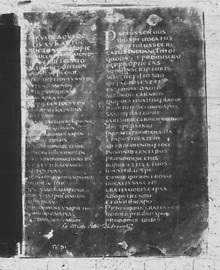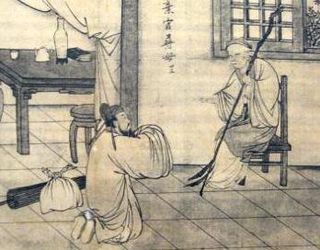Philology is the study of language in oral and written historical sources; it is the intersection of textual criticism, literary criticism, history, and linguistics. Philology is also defined as the study of literary texts as well as oral and written records, the establishment of their authenticity and their original form, and the determination of their meaning. A person who pursues this kind of study is known as a philologist.

The Codex Vaticanus, designated by siglum B or 03, δ 1, is a fourth-century Christian manuscript of a Greek Bible, containing the majority of the Greek Old Testament and the majority of the Greek New Testament. It is one of the four great uncial codices. Along with Codex Alexandrinus and Codex Sinaiticus, it is one of the earliest and most complete manuscripts of the Bible. The codex has been dated palaeographically to the 4th century.

Textual criticism is a branch of textual scholarship, philology, and of literary criticism that is concerned with the identification of textual variants, or different versions, of either manuscripts or of printed books. Such texts may range in dates from the earliest writing in cuneiform, impressed on clay, for example, to multiple unpublished versions of a 21st-century author's work. Historically, scribes who were paid to copy documents may have been literate, but many were simply copyists, mimicking the shapes of letters without necessarily understanding what they meant. This means that unintentional alterations were common when copying manuscripts by hand. Intentional alterations may have been made as well, for example, the censoring of printed work for political, religious or cultural reasons.

Papyrus 46, designated by siglum 𝔓46, is an early Greek New Testament manuscript written on papyrus, and is one of the manuscripts comprising the Chester Beatty Papyri. Manuscripts among the Chester Beatty Papyri have had several provenances associated with them, the most likely being the Faiyum. It has been paleographically dated between 175 and 225, or early 3rd century CE. It contains verses from the Pauline Epistles of Romans, 1 Corinthians, 2 Corinthians, Galatians, Ephesians, Colossians, Philippians, 1 Thessalonians, and Hebrews. Some leaves are part of the Chester Beatty Biblical Papyri, and others are in the University of Michigan Papyrus Collection.

Henry Suso, OP was a German Dominican friar and the most popular vernacular writer of the fourteenth century. Suso is thought to have been born on 21 March 1295. An important author in both Latin and Middle High German, he is also notable for defending Meister Eckhart's legacy after Eckhart was posthumously condemned for heresy in 1329. He died in Ulm on 25 January 1366, and was beatified by the Catholic Church in 1831.
A manuscript culture is a culture that depends on hand-written manuscripts to store and disseminate information. It is a stage that most developed cultures went through in between oral culture and print culture. Europe entered the stage in classical antiquity. In early medieval manuscript culture, monks copied manuscripts by hand. They copied not just religious works, but a variety of texts including some on astronomy, herbals, and bestiaries. Medieval manuscript culture deals with the transition of the manuscript from the monasteries to the market in the cities, and the rise of universities. Manuscript culture in the cities created jobs built around the making and trade of manuscripts, and typically was regulated by universities. Late manuscript culture was characterized by a desire for uniformity, well-ordered and convenient access to the text contained in the manuscript, and ease of reading aloud. This culture grew out of the Fourth Lateran Council (1215) and the rise of the Devotio Moderna. It included a change in materials, and was subject to remediation by the printed book, while also influencing it.

Codex Sangermanensis designated by Dabs1 or 0319, α 1027 (Soden), is a tenth-century diglot manuscript, formerly in the library of St. Germain des Prés, Paris, hence its name Sangermanensis, "of Saint Germanus". It contains the Pauline Epistles, lacking most of 1 Timothy and parts of Romans and Hebrews. It is particularly notable as one of the two such copies which display clear evidence of having had Claromontanus as exemplar. It is now part of the National Library of Russia collection in Saint Petersburg.

A biblical manuscript is any handwritten copy of a portion of the text of the Bible. Biblical manuscripts vary in size from tiny scrolls containing individual verses of the Jewish scriptures to huge polyglot codices containing both the Hebrew Bible (Tanakh) and the New Testament, as well as extracanonical works.
The Jerusalem Colophon is a colophon found in a number of New Testament manuscripts, including Λ (039), 20, 153, 157, 164, 215, 262, 300, 376, 428, 565, 566, 686, 718, 728, 748, 829, 899, 901, 922, 980, 1032, 1071, 1118, 1121, 1124, 1187, 1198, 1355, 1422, 1521, 1545, 1555, 1682, 2145, and 2245. The full version of the colophon is
εὐαγγέλιον κατὰ Ματθαῖον ἐγράφη καὶ ὰντεβλήθη ἐκ τῶν Ἱεροσολύμοις παλαιῶν ἀντιγράφων τῶν ἐν τῷ Ἁγίῳ Ὃρει ἀποκειμένων ἐν στίχοις ͵βφιδ. κεφφ. τνε.
Minuscule 2815, α 253 (Soden), formerly labelled as 2ap in all catalogues, but subsequently renumbered by Aland, is a Greek minuscule manuscript of the New Testament, dated paleographically to the 12th century.

Minuscule 1739, α 78, is a Greek minuscule manuscript of the New Testament, on 102 parchment leaves. It is dated paleographically to the 10th century.
Minuscule 42, α107, known as Codex Maedicaeus is a Greek minuscule manuscript of the New Testament on parchment. Palaeographically it has been assigned to the 11th century. It has marginalia.
Minuscule 110, α 204 (Soden), is a Greek minuscule manuscript of the New Testament on parchment leaves. It has been palaeographically assigned to the 12th century. It has complex contents with full marginalia.
Minuscule 424, Ο12, is a Greek minuscule manuscript of the New Testament, on parchment. Palaeographically it has been assigned to the 11th century. Formerly it was designated by 66a and 67p.

The Twenty-four Filial Exemplars, also translated as The Twenty-four Paragons of Filial Piety, is a classic text of Confucian filial piety written by Guo Jujing (郭居敬) during the Yuan dynasty (1260–1368). The text was extremely influential in the medieval Far East and was used to teach Confucian moral values.
The Codex Sangermanensis I, designated by g1 or 7, is a Latin manuscript, dated AD 822 of portions of the Old Testament and the New Testament. The text, written on vellum, is a version of the Latin. The manuscript contains the Vulgate Bible, on 191 leaves of which, in the New Testament, the Gospel of Matthew contain Old Latin readings. It contains Shepherd of Hermas.
Uncial 0320, is a diglot Greek-Latin uncial manuscript of the New Testament on parchment. Palaeographically it has been assigned to the 10th-century. Formerly it was designated by Dabs2. The manuscript is very lacunose.
Genetic editing is an approach to scholarly editing in which an exemplar is seen as derived from a dossier of other manuscripts and events. The derivation can be through physical cut and paste; writing or drawing in a variety of media; quotation, annotation or correction; acts of physical defacement; etc. Genetic editing aims to reconstruct the sequence of actions on the manuscript and exactly which parts of the manuscript were acted upon. Where multiple manuscripts have been combined.
An exemplar is a person, a place, an object, or some other entity that serves as a predominant example of a given concept. It may also refer to:
In textual criticism, an archetype is a text that originates a textual tradition. By using a stemmatic approach, the textual critic tries to trace the oldest surviving manuscript and show the relationship it has to its ancestors. This makes it possible to compare changes made in different traditions branching off from the archetype, and develop an edition that reconstructs the text of the archetype as closely as possible.







